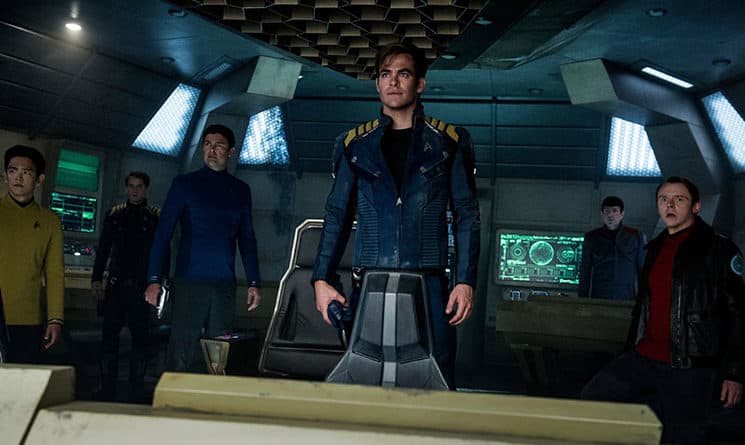In a canny bit of a wink early on in this, the 13th film in the ongoing mission of Star Trek on the big screen, engineer Montgomery “Scotty” Scott, played by all-around nerd superstar Simon Pegg, off-handedly identifies himself as a man whose job it is to “fix things.”
Pegg has been playing Scotty ever since J.J. Abrams’ 2009 reboot of the original crew from the 1960s series. But now, for the first time, he also plays the role of co-writer. His character’s remark is a good example of the subtlety Pegg is capable of deploying to comment on both the action on screen and the subtext that’s apparent only to geeks who follow such behind-the-scenes details.
Indeed, though the two previous Abrams films were met at the box office by generally satisfied audiences, critics and fans have pointed out several things that need fixing. The prior Abrams films’ reliance on huge set pieces, overly contrived call-outs to elements of the original cast’s adventures, and emergency missions to save Earth from certain destruction were fun, but they were just a little too insular, a little less hopeful, and conspicuously missing any actual trekking. For adventures that were famously built to explore “strange new worlds,” there was a vexing lack of new civilizations. In handing the writing duties over to Pegg — a successful genre scribe and life-long Trekker himself — the series has, it seems, found a fair degree of new life.
As the good Captain James T. Kirk (Chris Pine) dictates his ship’s log at the beginning of “Star Trek Beyond,” we discover that we are 966 days into the crew’s familiar Five Year Mission. This is a knowing nod to the show’s first airing in 1966, and it also effectively places the action in the fourth year of a journey that was infamously pulled off the TV airwaves after three seasons. It’s a smart jump that places the crew at a point where established relationships have evolved from when we last saw them: The Enterprise crew has finally become the team it was when it first hit TV screens in the ’60s. It’s one of many ways the script takes a deliberate step back while simultaneously moving the crew’s story forward.
Amid all the explosions, technobabble, and suitably retro lost-in-space iconography, the filmmakers even manage to embed a message of current social implication.
The conflict is similarly stepped down — which isn’t to say the threat to the lives of our favorite characters is any less dire. They are ambushed during a rescue mission in a remote nebula by a mysterious fleet of swarming alien drones and have their beloved Enterprise meticulously, painfully, and loudly dismantled around them. But the main drive of the story, much like some of the best episodes of the original show, is simply for the characters to engineer a way to find each other after having been separated.
Though Abrams’ fingerprints are still all over it, this latest outing is directed with a little more grit (and significantly less lens flare) by series newcomer Justin Lin, most famous for the rowdy and ridiculous grease-monkey shenanigans of the Fast and Furious franchise. Lin’s strengths with juggling a likeable ensemble cast and his eye for fetishizing vehicles and weaponry are firmly pedal-to-the-metal here, but so is his arguably over-frenetic style of cutting action scenes into dizzying, nigh-incoherent disarray. On one hand, the brain-rattling pace of the battle sequences certainly underscores the chaos of combat. But, on the other, it becomes very difficult to discern exactly where each player is in relation to the others.
This may have been Lin’s goal. It is remarked upon — several times, actually — that the nature of space is to have no up or down, and that disorientation is common among space travelers. And, indeed, it is in precisely this state that we experience Kirk’s personal showdown with the enemy fleet’s imposing commander. As respectably ambitious as it is to out-queasy the queasiest scenes of “Inception” and “Gravity,” Lin would do well to remember that not one person in his audience has ever actually signed up with Star Fleet.
But this is really just a quibble against an effort that so deftly balances the expectations of a contemporary big-screen blockbuster with the well-loved conventions of a three-generation-old boob-tube space western. Amid all the explosions, technobabble, and suitably retro lost-in-space iconography, the filmmakers even manage to embed a message of current social implication — one of the most important and subversive trademarks of the show since its launch 50 years ago. You might need to squint to see it, but it’s there.
The whole formula works far more playfully with the focus returned to the chemistry of the characters and to Trek’s self-contained episodic tradition (with not an Earth in sight). Though the bombast is turned up way higher than necessary, and the signal to noise ratio may not be in perfect parity, late-series creator Gene Roddenbery — who Simon Pegg still calls “The Boss” — would no doubt be proud. Dizzy and shaken, but proud. Set phasers to fun.

